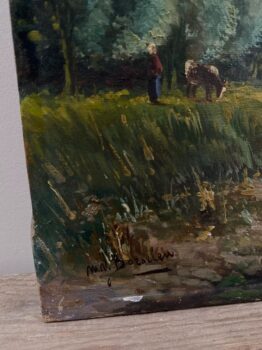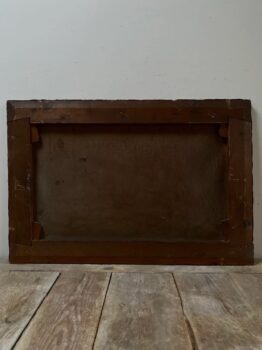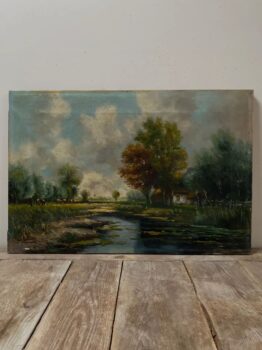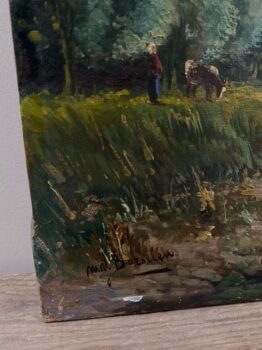This art appraisal report offers an in-depth and impartial assessment of the artwork in question, grounded in the appraiser’s expertise and familiarity with the art market. All the information and data analyzed in this report is sourced solely from the client.
Having a clear understanding of the value of your artwork is crucial in making informed decisions about its future. This report provides a precise estimate of the value of each piece, using US dollars as the base currency. It is not intended to encourage the sale of the artwork, but rather to provide valuable information on how to proceed should the client decide to do so in the future.
Detailed description of the artwork, including its medium, dimensions, and condition.
Checking Originality: Identification with Artificial Intelligence Test
In the quest to identify a match, Image Search employs advanced AI techniques to scour databases of images in order to find visually similar images. This is achieved through the use of various algorithms such as pattern recognition and machine learning. While some results may be considered as “matches” due to a clear similarity, other results may be inconclusive as they rely more on chance rather than any specific similarities. To conduct this test, a front-facing image was used as a reference to search for similar images on the internet.
The results of the automatic recognition are not conclusive. If a match is found, it will be shown below:
What specific information can we obtain from this test?
Our findings demonstrate this is a unique work of art; the comparison images in our gallery could not be matched with it. Even though there is always some uncertainty, we’ve found that this method gives accurate results 90% of the time, so it’s a good way to start figuring out if something is real. To completely identify the artwork, I continue to the next test.
Age estimation
In order to determine the age of an original painting by Jan Willem van Borselen (1825-1892), Oil on Canvas Rural Country Landscape Scene, certain characteristics can be used for evaluation. The frame construction can be a useful indicator of when the painting was produced. The frame style and materials used to construct the frame will have changed over time, and this can help to determine the general time period of the painting. The color palette used within the painting can also be an indication of the age of the painting. Different color palettes were popular in different eras and may help to provide an approximate date. Examining the painting's subject matter can also provide an indication of when the painting was done; themes, subjects and styles changed over time, and this can provide clues as to when the painting was created. Finally, the signature of the artist can help to provide an exact date of the painting's production. In the case of the specific painting in question, the artist's life span can be used to narrow down the production date range.
Based on this information and the pictures provided, I can estimate this painting was made circa mid to late 19th Century.
The origins of the wooden wedges on the corners of 19th century paintings are somewhat mysterious. Some experts believe that they were originally used to help keep the canvases taut, while others believe that they served as a way to protect the edges of the paintings from damage. Regardless of their original purpose, these wedges have become an important part of the history of art. Over time, they have come to be seen as an essential part of the works themselves, and they are often carefully preserved when paintings are restored. In some cases, the wedges have even been replaced with exact replicas when originals are lost or damaged. As a result, these humble pieces of wood have come to play a significant role in the world of art.
Condition of the artwork
This original painting by Jan Willem van Borselen is in good to excellent condition, with no restoration needed. There are no appreciable damages, and if there are any, they are minimal. The painting depicts a rural country landscape scene, with stunning detail and vibrant colors, making it a true masterpiece. This artwork is sure to add a unique touch to any room and is sure to be admired for years to come.
Artist’s name, biographical information, artwork’s provenance (history of ownership) and exhibition history.
I study and research the signature of artwork to see if it matches any known signatures. At this step, I also inspect the painting’s front and back pictures, to find an artist’s name or other identifying features like stickers that may help me identify who has made this work. If there is any, provenance is also seen as an important variable because it helps figure out who the artist is.

A close picture of the signature is included in this report.
I can read the signature as:
Borselen
At this point, I can use the signature and try to find the artist’s name in a database of known-listed artists. Basically, it is a database with information about the names, surnames, origins, and biographies of the most well-known artists.
I found that the artist who painted this artwork is a listed and well known artist,
Jan Willem van Borselen
(1825-1892)
Willem van Borselen was a Dutch landscape painter associated with the Hague School. He was the son of Pieter van Borselen, a landscape painter and lithographer who gave him his first lessons. He moved to The Hague and joined the Pulchri Studio, where he took up an apprenticeship with Andreas Schelfhout and became acquainted with the Royal Family. He was known for his small landscapes of meadows, clouds, and fluttering reeds, and he also took up watercolors in the 1870s. He was awarded the Order of the Oak Crown by King William III and was a teacher to Théophile de Bock.
Detailed analysis of the artwork’s style, subject matter, and significance within the artist’s oeuvre and the broader art world.
I can check if the style and type of painting match those of the artist referenced.
An original painting by Jan Willem van Borselen features a unique and expressive style. The oil on canvas painting captures a rural country landscape scene with a bold use of color, strong brushstrokes and an energetic composition. The use of light and shadow creates depth and dimension, giving the painting an almost three-dimensional feel. The painting is further enhanced by the artist's unique and creative use of line and form. Overall, the painting is vibrant, energetic, and full of life.
Comparable sales information, including prices realized at recent auctions or private sales of similar works by the artist or in the same medium.
In order to provide an up-to-date estimate of the fair market value of the original painting by Jan Willem van Borselen (1825-1892), oil on canvas depicting a rural country landscape scene, I utilized the data collected, including auction prices and other relevant market information. This is crucial as it can be used in various contexts such as insurance, estate planning, and art market analysis. It also offers a valuable insight into how the valuation of the artwork may have changed due to environmental or economic factors that could have affected the demand and supply of the painting.
The auction prices were a significant factor in determining the current market value of the artwork, as they are based on actual transactions between buyers and sellers in the art market. As such, they are a strong indicator of the expected value of the piece in the near future.
By analyzing auction results from the last 6 months, I was able to accurately determine the current fair market value of the artwork. This approach provides a comprehensive view of how the value has changed over time and gives insight into any potential areas of appreciation or depreciation in its price. Additionally, it allows me to adjust my valuation as new auction prices become available.
Conclusion
Investing in art can be a great idea for anyone looking to diversify their portfolio. Art has proven to be a reliable store of value and can provide a hedge against inflation and market volatility. Buying a piece of artwork can also be a great way to invest in something that you can enjoy in your home or office. Not only will you be able to appreciate the beauty of the artwork, but its potential value could also appreciate over time. It can be a great way to create a lasting legacy for your family, or just to add a unique touch to any room. An original painting by Jan Willem van Borselen, such as a rural country landscape scene, can be the perfect investment to make.
This painting can be considered valuable by the art market because it is an original painting by a well-known artist, Jan Willem van Borselen (1825-1892). The painting is also an oil painting on canvas, which is a medium that is highly sought after and collectible. Furthermore, the painting is a rural country landscape scene, which is a popular subject in art and has been desired by art lovers for centuries.
Final Appraisal Value ($)
7,000-8,000$
Appraisal Report made by:
Andrés Gómez
BSc, MSc, Expert Art Appraiser
10+ years of experience in Online Art Appraisals
100k+ Customers Served
Antique Store Owner
You can check my portofolio of past appraisals here:
https://www.appraisily.com/andres-portofolio/

Relevant photographs or supporting documentation, such as condition reports or expert opinions
A detailed summary of the appraisal process and the appraiser’s qualifications.
Mark-to-market art appraisal is a vital method for determining the current value of a piece of artwork. This form of valuation requires an appraiser to consider various factors, such as market conditions, the condition and age of the artwork, and the artist’s reputation. By taking all these elements into account, a mark-to-market art appraisal delivers an accurate assessment of a piece of artwork’s current market value.
The artist’s reputation, as determined by their track record in gallery and museum shows, awards, and other accomplishments, is also considered in mark-to-market art appraisal. Appraisers use this information to determine if the value of a piece is likely to increase or decrease over time. Additionally, they will inspect the condition of the artwork and note any signs of wear or damage that might affect its future resale value.
When performing mark-to-market art appraisals, appraisers also consider market conditions by researching current art market trends and comparable works that have recently sold. This information is used to provide an estimate of a piece’s worth at that point in time. By considering all of these factors, mark-to-market art appraisal is able to give a reliable indication of the current value of a work. This kind of valuation can also ensure fair prices are paid and received when buying or selling art.
In summary, mark-to-market art appraisal is a crucial tool for determining the true value of a piece of artwork, enabling buyers, sellers, and appraisers to make informed decisions regarding its worth. It takes into account multiple aspects to provide an accurate assessment of the current market value of a work. This information can be used to ensure that buyers and sellers are getting a fair price for the artwork, and that the appraiser’s valuation is up-to-date and reflective of current market conditions.
In the case of insurance replacement appraisals, mark-to-market art appraisals can also be used to accurately estimate the cost of replacing a lost or damaged artwork. The current value, as determined by the appraisal, is then used to determine the amount that the insurance company will pay back to the policyholder. This way, policyholders can rest assured that they will receive an appropriate sum for any artwork that needs to be replaced due to accidental damage or theft. Additionally, this kind of valuation helps insurers ensure they are not being overcharged when artwork needs to be replaced as part of a claim settlement.
The appraisal process is a thorough evaluation of the item or items in question. It involves researching and analyzing the information provided by the requester in order to provide an accurate estimate of its value. The appraiser takes into account factors such as condition, rarity, demand, and market prices. Photographs and detailed descriptions are especially important when providing an appraisal, since they help the appraiser identify any potential flaws or defects that could affect the item’s worth. By using all the resources that are available, an evaluation can be done quickly, efficiently, and with a high level of accuracy.
A statement of the appraiser’s liability and any potential conflicts of interest.
A qualified art appraisal, also known as a formal written evaluation, is a professional assessment of the monetary value of a piece of art by an individual who has specialized knowledge, expertise, and training in the field of art appraisal. This person must meet certain educational and professional requirements, including experience in researching and evaluating art, as well as knowledge of the art market and current market trends. The purpose of a qualified art appraisal is to provide an objective and unbiased opinion of the value of a piece of art for various purposes, including insurance claims, tax planning, estate planning, or to help determine a fair price for a sale or purchase.
We are committed to providing our clients with the most accurate and unbiased appraisal reports. To ensure impartiality, we adopt a flat rate, fixed fee structure for all appraisals, instead of a percentage-based fee. This eliminates any potential conflicts of interest between the art appraiser and the final report value. Our appraisal reports are in compliance with the Appraisal Foundation’s USPAP (Uniform Standards of Professional Appraisal Practice) standards and guidelines, which are widely accepted as the ethical and performance standards for appraisers. This guarantees that our reports are of high quality and legally defensible.
How to sell this artwork.
We have a structured guide to help you sell your artwork, you can find it here.











